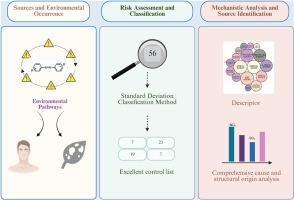偶氮染料的人类健康、生态毒性和降解产物的风险识别:制定优先控制清单
IF 7.3
2区 环境科学与生态学
Q1 ENVIRONMENTAL SCIENCES
引用次数: 0
摘要
偶氮染料是一种具有高稳定性和持久性的合成着色剂,具有遗传毒性、致癌性和生态风险。本研究对56个ADs和191个预测降解产物进行了系统评价。吸收、分布、代谢、排泄和毒性(ADMET)分析量化了毒性终点。通过标准间相关性的标准重要性(critical)方法确定指标权重,而基于理想解相似性的顺序偏好技术(TOPSIS)方法验证了鲁棒性。采用标准偏差方法建立了优先控制清单,确定了特别关注的7个ad。机器学习和因素分析显示,电负性、分子体积和硝基取代基是毒性的关键驱动因素,而磺酸基降低了风险。结构可追溯性证实- N=N键裂解产生有害的芳香胺。这些发现为危险染料的风险识别、监管协调和优先排序提供了一个简明的框架,从而支持开发更安全的替代品。本文章由计算机程序翻译,如有差异,请以英文原文为准。


Risk identification of human health, ecotoxicity, and degradation products of azo dyes: development of a priority control list
Azo dyes (ADs) are synthetic colorants with high stability and persistence, posing genotoxic, carcinogenic, and ecological risks. In this study, 56 ADs and 191 predicted degradation products were systematically assessed. Absorption, distribution, metabolism, excretion, and toxicity (ADMET) analysis quantified toxicity endpoints. The Criteria Importance Through Intercriteria Correlation (CRITIC) method determined indicator weights, while the Technique for Order Preference by Similarity to an Ideal Solution (TOPSIS) method validated robustness. A standard deviation approach was used to establish a priority control list, identifying seven ADs as being of special concern. Machine learning and factor analysis revealed that electronegativity, molecular volume, and nitro substituents were the key drivers of toxicity, while sulfonate groups reduced risks. Structural traceability confirmed that –N=N– bond cleavage produces hazardous aromatic amines. These findings provide a concise framework for risk identification, regulatory alignment, and prioritization of hazardous dyes, thereby supporting the development of safer alternatives.
求助全文
通过发布文献求助,成功后即可免费获取论文全文。
去求助
来源期刊

Environmental Pollution
环境科学-环境科学
CiteScore
16.00
自引率
6.70%
发文量
2082
审稿时长
2.9 months
期刊介绍:
Environmental Pollution is an international peer-reviewed journal that publishes high-quality research papers and review articles covering all aspects of environmental pollution and its impacts on ecosystems and human health.
Subject areas include, but are not limited to:
• Sources and occurrences of pollutants that are clearly defined and measured in environmental compartments, food and food-related items, and human bodies;
• Interlinks between contaminant exposure and biological, ecological, and human health effects, including those of climate change;
• Contaminants of emerging concerns (including but not limited to antibiotic resistant microorganisms or genes, microplastics/nanoplastics, electronic wastes, light, and noise) and/or their biological, ecological, or human health effects;
• Laboratory and field studies on the remediation/mitigation of environmental pollution via new techniques and with clear links to biological, ecological, or human health effects;
• Modeling of pollution processes, patterns, or trends that is of clear environmental and/or human health interest;
• New techniques that measure and examine environmental occurrences, transport, behavior, and effects of pollutants within the environment or the laboratory, provided that they can be clearly used to address problems within regional or global environmental compartments.
 求助内容:
求助内容: 应助结果提醒方式:
应助结果提醒方式:


